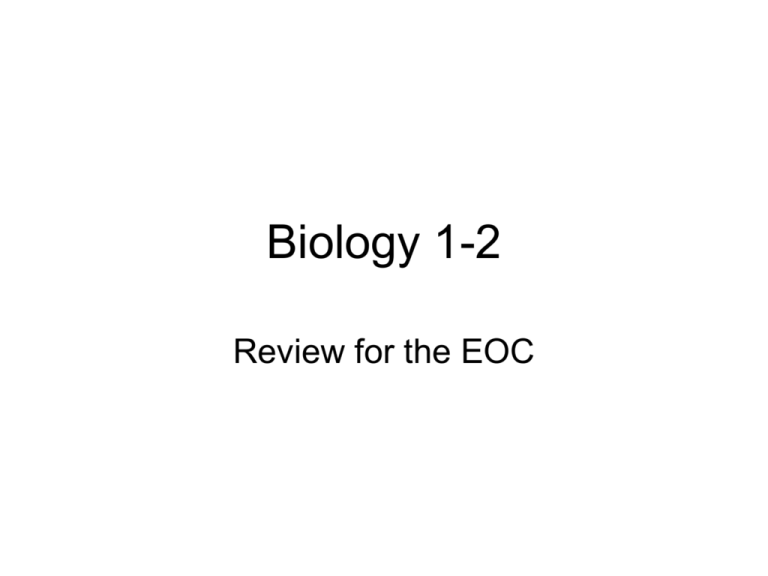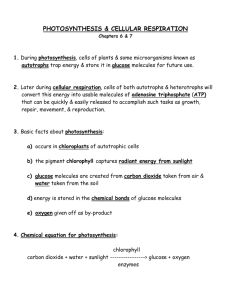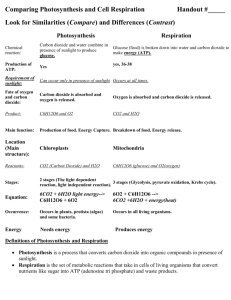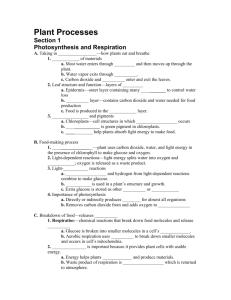EOC Review
advertisement

Biology 1-2 Review for the EOC Vocabulary Found in Many Short Answer or Multiple Choice Questions • • • • • Reliability Validity Unintended Consequences Equilibrium Constraint Reliability vs. Validity Reliability • Are your results repeatable? • Ensuring reliability means: – Multiple trials – Similar results when tested over and over again – Another scientist should be able to repeat your experiment and get the same results Validity • Is your experiment controlled? • Ensuring validity means: – Following steps to scientific method such as: – Having a proper control set-up (experiment without the manipulated variable … the normal situation) – Accurately measuring Unintended Consequences • A result that took place based on your action that you didn’t intend to happen … Ooops! • Example: – Action: Spray insecticide to kill mosquitoes – Result: More animals die because the mosquitoes are gone and that was their food source or the poison builds up along the food chain and the top consumers die. • Example: – Action: Remove wolves from Yellowstone National Park – Result: Herbivores (elk, deer) reproduce too fast and eat all the vegetation so their population actually go down along with many other species. Equilibrium • Balance or Homeostatis (steady state) • Sometimes we call this negative feedback because it tends to work in a cycle. – Examples: • Temperature and Blood Sugar regulation Constraint • Something that makes a project difficult to do or undertake. • For example, not every experiment or field study is possible to do perfectly because of these restrictions: – Schedule … enough time? – Risk … can I get hurt? – Resources … space or material? – Budget … too expenseive? – Quality … can it be well done? – Scope … is it relevant? Lab Investigations Experimental Design and Observational Experimental Variables and Set-ups Variables • Manipulated variable – What you change. – What your experiment is testing? – Ex: color of light on plant growth (change light color) • Responding variable – What you measure (growth) • Contolled varialbes – Keep the same between setups (same amount of water, soil, temperature, etc.) Set-ups • Experimental Set-ups – Set-ups in which you change the manipulated variable – Example: plants grown with blue light, red light, green light • Control Set-up – Used to compare with the experimental set-ups to find out if the manipulated variable had an effect – Example: plants grown in regular light Experimental Design Labs What’s Alive? – what was manipulated • BTB is used to detect Carbon Dioxide 9/24/14 9/27/14 Figure 1 • Did the beans produce Carbon Dioxide? Using a control • Use a control with ONLY ONE DIFFERENCE to be sure that the beans were the cause of the change in BTB. 9/24/07 Figure 2 9/27/07 Notice: The control is without beans. Therefore, beans must have caused the change. Liver Lab – what was manipulated? • H2O2 + liver (catalase) • H2O2 is hydrogen peroxide • Catalase H2O + O2 – Breaks hydrogen peroxide into water and oxygen • Time of O2 (oxygen) bubbles released was measured • Enzyme characteristics: – – – – Can be reused over and over again Cold temperature slows them up Warm temp speeds them up Can be destroyed if boiled … don’t work Egg Lab • Osmosis – The diffusion of water • Hypertonic (saltwater) – More salt outside the cell – Water moves out and cell shrinks • Hypotonic (freshwater) – Less salt outside the cell – Water moves in and cell swells/bursts • Isotonic – Same salt in and out of the cell – No change in mass (water moves equally in and out) Carbon Dioxide and Exercise • When you exercise you exhale more carbon dioxide. Why? – The mitochondria is working more to produce ATP so you have energy and carbon dioxide is a waste product of this process. Specifically, the carbon dioxide is coming from the Kreb’s cycle in the mitochondria. – In this lab, we noticed that the “pink solution” turned clear much faster after exercise than it did at rest. – http://www.phschool.com/science/biology_place/biocoach/cellresp/intro.html Yeast Lab – How does the amount of food (molasses) affect respiration? Amount of CO2 produced (air bubble in the tube) Molasses concentration (low to high) Aerobic Respiration uses oxygen C6H12O6 + O2 CO2 + H2O + ATP 3 Basic Steps: 1) Glycolysis (in the cytoplasm) glucose pyruvate + ATP + NADH 2) Kreb’s Cycle (mitochondria) pyruvate NADH + FADH2 + ATP + CO2 3) Electron Transport Chain (mitochondria) NADH + FADH2 + O2 ATP + H20 Anaerobic Respiration • Without Oxygen – No electron transport chain … less ATP • 2 types: 1)Alcoholic fermentation: (bacteria, yeast) Pyruvate + NADH Ethanol + NAD+ + CO2 2)Lactic Acid fermentation: (animals like you) Pyruvate + NADH Lactic Acid + NAD+ What’s different about these two equations? How can you set up an experiment to detect the difference? Photosynthesis Lab – Leaf Disc • What was being manipulated? • What happened? • What would determine whether the experiment was reliable and valid? Snail and Elodea • Use BTB to detect the release (produced) of Carbon Dioxide. – Blue to green or yellow show this. • Use BTY to detect the use (taken in) of Carbon dioxide. – Yellow to green or blue shows this. Hypothesis 1: Snails produce CO2. Experimental Control BTB BTB Hypothesis 1: Results Experimental Control BTY BTB Results: Snails produce carbon dioxide Hypothesis 2: Elodea takes in CO2. Experimental Control BTY BTY Hypothesis 2: Results Experimental Control BTB BT BTY BT Results: Elodea uses carbon dioxide in the light. Hypothesis 3: Snails produce CO2 in the dark. Experimental Control BTB BTB Hypothesis 3: Results Experimental Control BTY BTB Results: Snails produce carbon dioxide in the dark Hypothesis 4: Elodea uses (takes in) CO2 in the dark. Experimental Control BTY BTY Hypothesis 4: Results Experimental Control BTY BT BTY BT Results: Elodea does not use carbon dioxide in the dark. Hypothesis 5: Elodea produces (releases) CO2 in the dark. Experimental Control BTB BTB Hypothesis 5: Results Experimental Control BTY BTB Results: Elodea produces carbon dioxide in the dark. Observation Labs Diffusion Lab with Dialysis Tubing • Diffusion – The movement of molecules from an area of high to low concentration • Permeable – Molecules can pass through the membrane • Impermeable – Molecules cannot pass through the membrane • Semipermeable – Some molecules can pass through the membrane while others cannot Why are cells so small? Size (cm) SA:V 3x3 2:1 2x2 3:1 1x1 6:1 0.5 x 0.5 12 : 1 Conclusion: Small cells have a larger SA:V ratio. This ratio allows the cell to diffuse materials in and out more efficiently. Which cell would you want to be? Why? Cell A Cell B Answer: Cell B Surface Area : Volume (SA:V) ratio is greater! Access to nutrients and waste removal is easier. Time for Mitosis • www.biology.arizona.edu – Click on Onion Root Tips at the Top and follow the directions – Mitosis is the type of cell division that makes exact copies of cells for growth and repair Interphase Number of cells Percent of cells Prophase Metaphase Anaphase Telophase Total 36 100% Biomolecules What are Organic Compounds? • Sugars, Fats, Food, Yourself! – Compounds that contain carbon (basis of all living things) – Extracted from living things – Examples: Pancakes, Beef, Bread, Butter • Inorganic Compounds – Usually do not contain Carbon – Examples: Salt, Rust, Water. All Organic Compounds have a Monomer-Polymer relationship • Monomers – Sub-units – Building blocks of a larger structure • Examples: – Monosaccharides » glucose – Amino acids – Fatty acids – Nucleotides • Polymers – Larger molecules – Two or more monomers linked together. • Examples: – Polysaccharides » starch – Proteins – Fats – DNA or RNA You Are What You Eat! • • • • Carbohydrates Proteins Lipids Vitamins and Minerals What happens now? • When you repair yourself or form new parts you have to put together many molecules. • The food you eat needs to be broken down! • You can then piece back together the small parts to make you! Metabolism (break down and build up reactions) Keep in mind you are what you eat. You breakdown your food and rearrange it to make the molecules that build and repair your cells. Food is used for energy and building blocks. Carbohydrates • General Formula: CH2O • Example: C6H12O6 (glucose) • Pasta, Apple pie, Chocolate cake, Juice! • Simple Energy Source 3 types of carbohydrates: – Monosaccharides • One molecule of sugar • Glucose, Fructose – Disaccharides • 2 monosaccharides linked together • Maple Syrup, Lactose (milk sugar) – Polysaccharides • Many monosaccharides linked together • Starch, Glycogen(stored energy in our liver and muscle), Cellulose (used to thicken ice cream). Proteins • Made up of Amino Acids • C, H, O and N • Functions: – Some energy storage – Make up many parts of our body • Ex: Hair, Blood cells, Hormones (insulin) – Enzymes: special proteins that speed up a chemical reaction. Lipids • C, H, O • High Energy Storage • Types – Fats: Glycerol and Fatty Acids • Saturated vs. Unsaturated Fats – Steroids: Cholesterol – Oils – Waxes – Phospholipids: make up cell membranes Enzymes • Special proteins that speed up chemical reactions to a biologically useful rate. • Examples: – – – – Salivary amylase – breaks starch into glucose Catalase – breaks hydrogen peroxide into water and oxygen Protease – breaks proteins into amino acids Lipase – breaks fats into fatty acids and glycerol Enzymes have an optimal environment at which they work best The Cell The cell theory a) Cells are the basic unit of life b) All living things are composed of cells c) Cells arise from preexisting cells • Plant from plant • Animal from animal Cell membrane – phospholipid bilayer Phosphate head like water (hydrophilic). Lipid tails don’t like water (hydrophobic). Some molecules can slip through the phospholipid bilayer but many molecules will have to use a protein channel (not shown) to get through. Cell Parts and Their Jobs Parts of the cell: • Cell membrane – “gate keeper” • Nucleus – Contains DNA • Chromosomes – “blueprints” • Nucleolus – Makes ribosomes • Cytoplasm – Jelly-like inside of cell where most reactions take place Cell organelles: • Mitochondria • “powerhouse” • Golgi apparatus – “packaging dept.” • Lysosome – “shredder”, digestion • Endoplasmic reticulum – “transportation dept.” • Chloroplast – Makes food via photosynthesis • Vacuole – “storage” of water/food Animal vs. Plant Cell • Animal Cell – Round – No cell wall – Centriole for division • Plant Cell – Rectangular – Cell wall – Chloroplast for photosynthesis http://www.biolessons.com/lessonplans/cellularbiology/plant_animal_cell/plant_animalcell.asp Different Cells • Prokaryote – – – – Bacteria No “true” nucleus Cell wall No organelles with membranes • Eukaryote – Animal and Plant – Organelles – Nucleus Movement in and out of Cells • Diffusion – Movement of molecules from high to low concentrations – No energy needed • Passive transport • Facilitated Diffusion – Need a protein channel but still passive • Active Transport – Uses energy to move molecules from low to high concentration • Osmosis – Diffusion of water (no energy) Transport in/out of Cells Some times molecules are so big they can’t even fit through the protein channels. The membrane can fold in or out to form vesicles that carry lots of material. Endocytosis – membrane folds in and brings along the materials it needs. Exocytosis – membrane folds out and gets rid of waste or sends out materials for other cells. Cells and Solutions • Hypotonic – Less solute (salt) outside the cell – “freshwater” • Hypertonic – More solute (salt) outside the cell – “saltwater” • Isotonic – Equal solutes in/out of cell Cellular Reproduction • Cell Cycle – Interphase • G1 • S • G2 – Mitosis • • • • Prophase Metaphase Anaphase Telophase – Cytokinesis Interphase • G1 – General cell growth • S phase – DNA replication • G2 – Second growth phase, organelles double Mitosis makes exact copies of the cell for growth and repair. Meiosis makes sex cells with only half the chromosomes (one of each kind) for reproduction. Mitosis would copy each chromosome and divide them evenly to make two identical cells. Meiosis would copy each chromosome and then divide them twice so that the egg and sperm end up with only one of each kind (one #1, one #2 and so on). What’s the chance a child will receive the exact egg or sperm as their sibling? Looking at the chromosomes can you determine the gender of the person? Mitosis vs. Meiosis • Mitosis animation: Click the link below – http://www.lewport.wnyric.org/jwanamaker/ani mations/mitosis.html • Meiosis animation: Click the link below – http://www.lewport.wnyric.org/jwanamaker/ani mations/meiosis.html Photosynthesis and Respiration Photsynthesis and Respiration • What’s energy? • What’s ATP? • How is energy released? Energy All living cells use energy for life processes. • Original source is our Sun. • Autotrophs ("self-feeding") = change light energy into food energy. – Green plants, algae • Heterotrophs ("other feeding") = obtain their energy from other organisms. – Animals Photosynthesis Sunlight +H2O + CO2 WATER CARBON DIOXIDE O2 + C6H12O6 OXYGEN GLUCOSE The process by which green plants change light energy to food energy. Occurs in the chloroplast. energy input from sun PHOTOAUTOTROPHS (plants, other producers) nutrient cycling HETEROTROPHS (consumers, decomposers) energy output (mainly heat) Respiration • The release of energy from sugar or starch for use by the cell • Occurs in the mitochondria C6H12O6+ O2 CO2 + H2O + energy (ATP) Products of respiration are used as reactants in photosynthesis. Photosynthesis and Respiration are cycles that work together. Phototsynthesis needs C02, water and sunlight to make glucose. Respiration needs glucose and O2 and releases energy ATP ATP adenosine triphosphate, the energy molecule that powers most cellular work ATP is like a battery that can be recharged. ATP ADP The Overall Equation for Cellular Respiration • A common fuel molecule for cellular respiration is glucose Glucose Oxygen Carbon dioxide Water Energy – This is the overall equation for what happens to glucose during cellular respiration • The efficiency of cellular respiration (and comparison with an auto engine) Energy released from glucose (as heat and light) Energy released from glucose banked in ATP Gasoline energy converted to movement About 40% 25% 100% Burning glucose in an experiment Figure 6.2B “Burning” glucose in cellular respiration Burning gasoline in an auto engine Genetics Essential Vocab • Genotype – the symbolized form; gene forumula (ex: BB) • Phenoypte – physical appearance/description (ex: brown) • Homozygous – 2 genes that are the same (ex: BB or bb) ; Pure Bred • Heterozygous – 2 genes that are different (ex: Bb) ; Hybrid • Dominant – the stronger gene; appears in the phenotype if present • Recessive – the weaker gene; appears in the phenotype only when homozygous Punnett Square Possible offspring: Parent 1 x CC x Parent 2 cc Genotypes: 100% Cc Phenotypes: 100% Curly Central Dogma Review DNA to RNA to protein (trait) What is this process? A. B. C. D. E. F. G. H. Nucleus mRNA Ribosome tRNA Anticodon Codon mRNA What are methionine and asparagine? Can you determine the base sequences? DNA complementary strand: CGG GTC GAT ATA GCC CAG CTA TAT mRNA sequence: CGG GUC GAU AUA DNA template strand: amino acid sequence (polypeptide): tRNA’s: Arg – Val – Asp – Ile GCC CAG CUA UAU Ribosomes read the mRNA codons (3 letters) and the tRNA brings in the appropriate amino acid to build the protein (polypeptide). If you change the DNA (mutation) it changes the mRNA which changes the protein. Evidence of Evolution Fossil Record • • • • Shows a tremendous variety of organisms Organisms come and go Reconstruct changes of organisms Infer behaviors (ex: sharp teeth = carnivore) Morphology • Similar types of body structures • Homologous Structures – Show common ancestry – Example: teeth of a bear and teeth of a dog – Example: arm of a human and flipper of a whale • Analogous Structure – Common function but not a common anscestor – Example: wings of a bird and wings of butterfly Biochemical and Molecular • Exact same chemical makeup in biomolecules – – – – Carbohydrates (sugars) – C,H,O Proteins (amino acids) – C,H,O,N,S Lipids (fats/oils) – C,H,O Nucleic acids (DNA, RNA) – C,H,O,P • Similar metabolic processes from humans to bacteria (same chemical reactions) • Process of: DNA RNA protein is the same Embryology • Embryos of fish, lizards, turtles, chickens, pig, mice and humans are very similar. • Embryonic pattern of development seems to be retained in many organisms. Biogeographical data • Organisms unique to a certain location that has been isolated for a long time. – Example: Madagascar has a variety of unique organisms (lemurs) • Organisms with very similar body plans are found in different areas around the world. – Example: Flightless birds (kiwi, ostrich, rhea, emu, cassowary) What’s a Species? ••How Can different types might you separate these Do different types ofof dogs mate andand produce NO! … 17 different species cichlids mate dogs fish into into different different species? species? viable offspring that can produce viable offspring also reproduce? that can also reproduce? YES! … only 1 species • Are horses and donkeys considered to be the same species? • What is a species? Even though the horse and the – A group of organisms donkey can create offspring (a so similar mule), mules are sterile.to one another that they can Since mules cannot reproduce the interbreed and produce horse and the donkey are fertile offspring considered to be different species. Reflecting on the “biological species” concept (tigers and lions) … list criteria required if organisms are to be of the same species. Interbreed in nature Produce fertile offspring Share common habitats Have similar body structures Have similar behaviors Darwin’s Theory of Natural Selection • • • • • Organisms reproduce others of their kind More offspring than can survive to reproduce There are variations within populations Some variations are favorable Organisms with the favorable variation will survive to reproduce • Over long periods of time, favorable adaptations make up most of the population Natural Selection Mechanisms Normal Distribution – Bell Curve Almost everything you can think of fits this curve! Directional Selection Breeders always select for the fastest greyhounds Selects for: One extreme trait Selects against: The most common and other extreme Disruptive Selection Selects For: The two extremes Selects Against: The most common Stabilizing Selection • Tall trees – Knocked over by wind • Short trees – Not enough sunlight • Medium trees – Perfect!? Selects For: The most common trait Selects Against: Both extremes Review Natural Selection is not “goal oriented” Only acts on traits that currently exists and are best suited for reproductive success in a particular environment Example: Tigers will not become blue just because they might want to I wish, but he exists only in my dreams. He’s not blue, but he’s better than nothing! Ecology Energy flows in, is transferred, and exits the ecosystem. Materials must be recycled within the ecoystyem. Food Chain • A linked feeding series Food Web • Multiple food chains interacting together Population • Group of the same type of organisms (species) living in an area Producers/Autotrophs • Make their own food; plants use photosynthesis Consumers/Heterotrophs • Eat other organisms for food and energy Decomposers • Breakdown dead material and recycle it back to the soil for plants to use Trophic Level Energy Source Primary Producer Sunlight energy Primary producer Herbivore Primary Carnivore Secondary Carnivore % Energy Released During Metabolism Herbivores Primary carnivore % Energy % Energy Released as Released in Waste Total Total kcal % Energy Transferred Left to be based on 20,000 Transferred kcal initial 60% 20% 80% 20% 4000 65% 20% 85% 15% 600 70% 25% 95% 5% 30 70% 25% 95% 5% 1.5 Energy Flow through trophic levels 4500 4000 3500 Kcal 3000 2500 2000 1500 1000 500 0 Primary Producer Herbivore Primary Carnivore Secondary Carnivore What do the rectangles represent? Tertiary consumers Secondary consumers Primary consumers (herbivores) Producers (plants) Each rectangle represents the amount of energy at each trophic level and thus the number of organisms that can be supported at that level. Food Web If the field mouse is removed the Garder Snake would die out because the field mouse is its sole source of food. The Red-tailed hawk would eventually die out as well because it only eats the field mouse and the garder snake (both of which have died out). Food Pyramid (one possible example) Trophic Levels Red-tailed hawk Garder snake Tertiary Consumer Secondary Consumer Elk, Moose, Field Mouse Primary Consumer Tumble Grass Producer Click Here to Go Back Carbon-Oxygen Cycle Photosynthesis and Respiration are responsible for most of the CarbonOxygen cycle. This cycle allows Carbon and Oxygen to be recycled and reused which is good because we won’t get more! Nitrogen Cycle Bacteria are the organisms mostly responsible for the Nitrogen cycle. The bacteria can “fix” nitrogen from the air, dead organisms and waste into chemicals that plants can use to make proteins and nucleic acids (DNA). Water Cycle Water is continual recycled throughout ecosystems through the process of evaporation, condensation, and precipitation.








